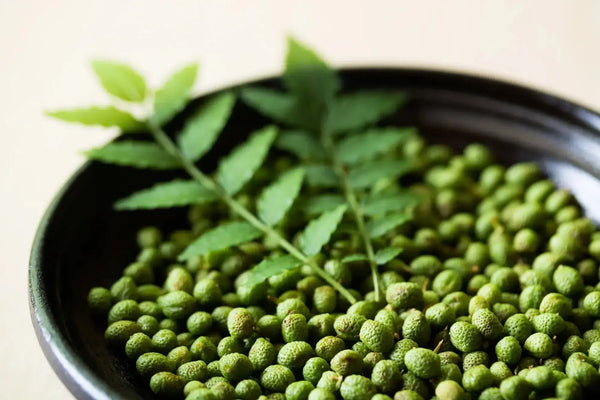
Jump to:
If I asked you to try a type of food made from something called a prickly ash tree, you might understandably be a little hesitant. However, Sansho, a Japanese condiment made from Zanthoxylum piperitum (or, as it is more commonly known, the Japanese prickly ash tree) is loved throughout Japan, and increasingly globally, for its unique citrusy and peppery flavor.
In this article, we will look at what Sansho is and how it is made, discuss its origins and history, compare it with Sichuan peppercorns, and look at the major areas of production. We will also explore the way it is used in food, including its intriguing connection to Wagashi sweets, consider the potential health benefits of Sansho, look at where you can purchase it, and round off by offering some storage tips.
What Is Sansho Japanese Pepper?

Sansho (literally “mountain pepper”) is a distinctive Japanese spice made by grinding the berries of the aforementioned Japanese prickly ash tree. It is enjoyed not only for its citrusy aroma, but also the effect of its spicy, numbing sensation on the tongue, which draws comparisons with Sichuan peppercorns. This unique tingling effect is caused by a compound called hydroxy-alpha-sanshool found in the berries.
In Japanese cuisine, Sansho is a versatile condiment used to enhance the flavors of various dishes, a key component of the spice blend Shichimi Togarashi, and used in soups, and dips for tempura, noodles, and other traditional dishes like Nabemono (hot pot). More on this later!
Origins and History Of Sansho
Sansho has a history that spans over 2,000 years, originating in ancient China. It was first recognized as "huajiao" in China, where it was highly valued for its unique culinary properties and medicinal uses. Chinese cooks cherished its ability to impart a distinctive tingly and numbing sensation, a characteristic known as "mala," which added a complex layer of flavor to dishes.
The spice made its way to Japan over a thousand years ago, where it quickly became deeply integrated into Japanese culinary traditions. Historically, Sansho was not only used to enhance the taste of food but also served as a preservative and a medicinal remedy, believed to aid digestion and alleviate various ailments. Its significance in Japan grew during the Heian period (794–1185), and it became particularly famous as a seasoning for grilled eel (unagi), a use that remains popular today.
As Sansho's use spread across Japan, various regions began cultivating their own varieties, further enriching the spice’s culinary application, and Sansho's enduring presence in both traditional and modern Japanese dishes highlights its cultural and historical importance.
Sansho vs Sichuan Peppercorns?

Sansho and Sichuan peppercorns, though similar in some respects, are distinct spices with unique characteristics that reflect their origins and uses in Japanese and Chinese cuisines, respectively.
Flavor Profile and Heat Level
Sansho, derived from the Japanese prickly ash tree, offers a tangy, citrusy flavor with notes of lemon and lime. It has a mild tingling sensation but lacks the intense numbing effect found in Sichuan peppercorns. Sansho’s subtle heat is gentle and not overly spicy, making it a versatile seasoning in Japanese cuisine. Conversely, Sichuan peppercorns, native to China’s Sichuan province, are known for their potent numbing and tingling sensation, which is more pronounced than Sansho's. They carry a citrusy, floral, and slightly woody taste, and while they provide some spicy heat, they are primarily valued for their numbing properties.
Appearance and Geographical Origin
Sansho appears as light green, spiky pods, while Sichuan peppercorns are small, reddish-brown or black with a rough texture. Sansho is native to Japan, while Sichuan peppercorns hail from China.
Culinary Uses
Sansho is a staple in Japanese cooking, commonly used to season grilled or braised meats, pickles, and noodle dishes. In contrast, Sichuan peppercorns are essential in Sichuan cuisine, where they are used in iconic dishes like mapo tofu and Kung Pao chicken. They are often toasted or fried to enhance their flavors and are frequently combined with chili peppers to create the "mala" flavor, balancing fiery heat with a numbing sensation.
Where Is Sansho Produced?

Sansho is produced in various regions across Japan, each known for its unique quality and characteristics. The most notable production area is Wakayama Prefecture, which is the largest producer, accounting for over 60% of the country’s total Sansho production. Wakayama Sansho is celebrated for its strong aroma and rich flavor, particularly in the town of Aridagawa. This region, with its mountainous terrain and temperate climate, has been a center of sansho cultivation for centuries, dating back to the Heian period (794–1185).
In Aridagawa, the variety known as Budo, or grape, Sansho, is especially prized. This variety was discovered in the Tenpo era (1831–1845) and is known for its large berries and strong fragrance. The cultivation of Budo Sansho became rooted in the region due to its culinary and medicinal applications, with the area's high altitude and snowy winters providing ideal growing conditions.
Other notable regions for Sansho production include Kyoto, particularly in Nishiki, where the "Nishiki Sansho" variety is known for its refined flavor, and Gifu Prefecture, recognized for its vibrant, citrusy Sansho. Hyogo Prefecture, especially the Tamba region, also contributes to Japan's Sansho production, with varieties known for their balanced flavor.
Culinary Uses Of Sansho

Sansho can be utilized in various forms, each bringing a unique taste and aroma to dishes. One of the most common culinary uses of Sansho is in meat and fish dishes. For example, it is often sprinkled on Unagi to enhance the rich flavors with its refreshing and peppery kick. It is also used in seasoning grilled beef tongue (Gyutan) and other meats, where its tangy taste complements the savory flavors.
In hot pot dishes like Sukiyaki and Shabu-Shabu, Sansho adds a citrusy aroma and a subtle numbing effect, making the dish more complex and invigorating. Sansho is also a key ingredient in the popular Japanese spice blend, Shichimi Togarashi which is widely used to season noodles, soups, and grilled meats, adding layers of flavor with each bite.
Beyond these applications, Sansho plays a significant role in pickles and preserves. It is often included in Japanese pickles (tsukemono) to impart a zesty, tangy flavor. The young leaves of the Sansho plant, known as kinome, are used as a garnish in various dishes, adding a fresh, tangy note and a vibrant green color. Kinome is particularly popular in spring dishes, where it enhances both the flavor and presentation of the meal.
Sansho is available in different forms depending on its stage of growth. The immature fruits, called Ao-sansho or Mi-sansho, are boiled with soy sauce and other ingredients to create Tsukudani, a savory condiment typically eaten with rice. Meanwhile, Kona-sansho, the dried and powdered form of the ripe fruit skin, is commonly used as a seasoning in dishes like Unagi-no-Kabayaki (grilled eel), where it balances the richness of the eel with its spicy, zesty flavor. If you want to make Unagi yourself, check out this recipe.
In addition to its culinary uses, Sansho is also recognized for its medicinal properties, as it is believed to have antibacterial, antifungal, and digestive benefits.
Is Sansho Used With Japanese Sweets?

Perhaps surprisingly, yes, it is. It is sometimes used in Wagashi, Japanese confectionery, to introduce a refreshing twist to their typically sweet profiles. While not as commonly employed as ingredients like red bean paste or matcha, Sansho’s citrusy and mildly numbing properties can complement the sweetness of Wagashi in several ways.
It is used to flavor the sweet red bean paste (Anko), adding a subtle aromatic citrus note that contrasts with the sweetness, creating a more complex taste. This is particularly appealing in Wagashi that aim to balance sweet and savory or spicy elements. The young leaves of the Sansho plant, known as kinome, are sometimes used as a garnish, adding both visual appeal and a fresh, herbal flavor when paired with rice cakes or jelly-like sweets.
Seasonally, Sansho is incorporated into Wagashi to evoke the freshness of spring and early summer. In modern interpretations, it is paired with ingredients like chocolate or fruits, blending traditional Japanese and contemporary flavors. Examples of Sansho-flavored Wagashi include Kiri Sansho, Nerikiri, Sansho Mochi, and Yokan, where the spice adds a unique, tangy dimension, balancing the sweetness with its distinctive taste. You can learn about all of these wagashi types and more in this article.
Is Sansho Good For You?
Sansho offers a range of potential health benefits, rooted in both traditional use and modern research. Traditionally used in Japanese medicine, Sansho is believed to aid digestion by stimulating appetite and improving digestive function, helping to alleviate indigestion and gastrointestinal issues. Its antimicrobial properties are supported by research showing that Sansho contains compounds capable of inhibiting the growth of harmful bacteria and fungi, making it potentially useful for both food preservation and promoting gut health.
As already noted, Sansho contains hydroxy-alpha-sanshool, and this compound has anti-inflammatory properties that may help reduce inflammation in the body, offering potential benefits for conditions like arthritis and other inflammatory diseases. It is also claimed that Sansho’s antioxidant activity can help protect the body from oxidative stress caused by free radicals, contributing to the prevention of chronic diseases such as heart disease and cancer.
Some studies suggest that Sansho may improve blood circulation, with its active components potentially enhancing blood flow and benefiting cardiovascular health. The numbing sensation caused by its compounds may also provide mild analgesic effects, offering relief from minor pain or discomfort. Moreover, Sansho is a good source of vitamins and minerals, including vitamin A, B vitamins, calcium, potassium, and magnesium, supporting overall good health.
Where Can You Buy Sansho In Japan?

You won’t have to go too far to find Sansho in Japan. In addition to when it is infused in pastes, oils, and other condiments, Sansho can be found in ground-powdered form, the berries from which you can grind it yourself, and the Kinome leaves.
Most grocery stores and supermarkets will have at least the ground form in their spice sections, and you can generally find all forms in specialty food stores, such as in Tsukiji Market in Tokyo, the food halls of major department stores, such as Takashimaya or Mitsukoshi, and regional famers’ markets in areas of the country famous for Sansho production, such as Wakayama Prefecture.
Another good source of Sansho and related products is the Internet. On the Japanese Taste website, you can find not only Sansho pepper itself in ground form, but also Shichimi, which, as previously explained, includes Sansho, and this blended condiment of Yuzu and Sansho, as well as Sansho-infused soy sauce and Sansho-flavored rice bran oil.
How To Store Sansho

The way that you store Sansho will depend on whether you have bought it in leaf, berry, or ground form.
Sansho Leaves
When storing leaves for a short period of time, wrap them in a damp paper towel, place them in an airtight container, and refrigerate them for up to a week. When storing for longer periods, preserve them in salt and refrigerate. You should not freeze Sansho leaves.
Sansho Berries
If you have purchased Sansho in berry form, you can refrigerate them in an airtight container for up to one week. For longer term storage, berries can be frozen and washing and drying them first. They can also be pickled in soy sauce or salt for an extended shelf life.
Sansho Powder
If you purchase Sansho powder in a container form, this is normally stored at room temperature, so you should follow the instructions on the container for storage restrictions. If you have bought loose powder, store it in an airtight container in a cool, dark place. For extended freshness, refrigerate or freeze the powder, ensuring it’s well-sealed.
Sansho – The Unique And Healthy Japanese Condiment
Sansho is a condiment that has been celebrated in Japan for its unique citrusy, peppery flavor and the distinctive numbing sensation it imparts on the tongue, since its introduction to Japan over a thousand years ago. Produced most prominently in Wakayama Prefecture, it started out as an herbal remedy for common ailments, but is now best known as a versatile flavor-enhancing condiment used in Shichimi spice blends, hotpot dishes, and various dipping sauces. Available in a variety of forms, including leaves, berries, and powder, Sansho is now known to offer several health benefits including improved digestion, reduced inflammation, and improved blood circulation.
Have you tried Sansho yet? Let us know your impressions of it in the comments.


0 comments